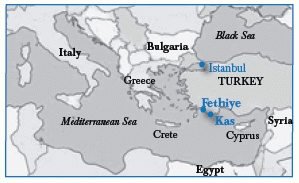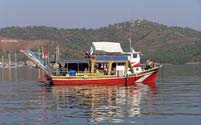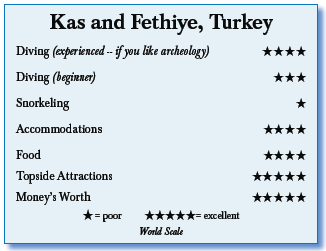Fethiye and Kas, TurkeyContents of this Issue: How A Diver Stumped Airport Security Underwater Photos with Digital Compacts Judge Calls Mistrial For a “Too Taxing” Stranded-Diver Case Do You Think Local Diving is Boring? Local Dive Highlights: Graveyards, Shark Teeth, Bowling Alleys Problems with Peeing in Drysuits Editorial Office: Ben Davison Publisher and Editor Undercurrent 3020 Bridgeway, Suite 102 Sausalito, CA 94965 in search of amphorae on the Mediterranean Coast from the May, 2010 issue of Undercurrent
Dear Fellow Diver: Exotic Turkey -- the muezzin call to prayer five times a day echoed throughout the Mediterranean coastal town of Fethiye, adding a magical touch when viewing the 2,500- year-old ruins of tombs. I am a woman traveling alone, as I often do, but I avoid irrational avoidance by educating myself about a destination beforehand. Just because the Kurdish Freedom Fighters blew up a bus of tourists in a nearby city four years ago doesn’t mean it will happen to me. I was to divide my two weeks between diving in Fethiye and Kas, where American divers are rare. I came to dive ancient wreck sites to see the Amphorae, unique and ancient vases, and they are there, in abundance. I showed up at the Dolphin Diving 45-foot dive boat-cum-office, where Colonel
Yilmaz Guven, one of Turkey’s first divers, was waiting to introduce me to the
“Turkish Diving Delights”, or so his website assured me. It was a package deal of
US$360 for three days diving and hotel for five nights. Excellent deal? Nope. With
only one boat, majority rules. Seventeen of 20 were first-time divers. Dolphin Diving’s day is 9 a.m. to 6 p.m. with only two dives planned; midday is for new divers. Colonel Yilmaz captains the boat, and both he and John are instructors. The craft was well-kept, with kitchen and clean head. Their yappy dog, Lucy, announced the comings and goings at docking. A lunch of spaghetti or pasta with chicken was prepared on board. Tanks were 80 cu ft aluminum. Old rental equipment not well maintained. Fellow divers assisted with entries and exits, especially negotiating the two-foot step-over to get to the dive platform in full gear. I once asked John if he could adjust my alternate air source for a free flow issue. He refused, saying he would be too busy filling tanks. On my birthday, Colonel Yilmaz took five divers on two of his special dives. The first was through a crack at 60 feet, progressing through two tunnels with ambient light during most of the seven-minute transit. Small golden and red sponges inhabited the tunnels. Exiting at 115 feet, the colonel directed us to Shrimp Cave, which a myriad of shrimp called home. Gradually ascending, we were met by schools of sea bream, popular lunch and dinner fare at the harbor restaurants. Small sea bass, several barracuda and fair-sized jacks were also spotted. On the next dive, we dropped anchor near the rocky shore at Amphora Bay, an amphora site dating back to 500 B.C., where endless ships have crashed upon the rocks. (Ours broke loose in the surge and nearly did the same). True to its name, there are many vases that have become firmly embedded over time, many intact and upright (removing them is forbidden). Hidden in crevices are three-inch azure vase sponges. Five- to 36-inch brown and bumpy Kerferstein’s sea cucumber were the most prevalent of any species, kept company by colorful peacock and spiral fan worms. Shades of brown dominate. It’s a good dive only if you are into archeology. Whereas John at Dolphin Diving looked at my C-cards, Barakuda Diving Center in Kas, 60 miles further east along the coast, requested my C-card, logbook, passport (required by the Turkish Coast Guard) and a medical exam from a physician. European divers come with them in hand. I was permitted to complete the medical form myself. I brought my own gear, but their Mares rental equipment was well maintained. Dive briefings with hand drawings were thorough, and they pointed out the safety equipment and oxygen setup on board. The closest hyperbaric chamber was a two-hour drive.
Dive guide Maume led me slowly on 70- to-85 minute deco dives, most to 100 feet. Four Brits diving for one day hoped to get a dive at Flying Fish, the home of a WWII Italian bomber resting at 190 to 230 feet. No dice, until the dive crew ascertained their diving expertise. I saw much more sea life here. Two dragonfish exuberantly mating was a highlight, as were some esoteric nudibranchs. Mediterranean morays fascinated me with their blue mouths, as did Turkey whitemouths. There were dozens of sea slugs at the Cave III site, with the 40-degree interior of the cave enough to fog goggles, diminish a flashlight, and see your breath after ascending inside. On all other dives, water at depth ranged from 71 to 83 degrees. Visibility was typically 100 feet. The September days were sunny, dry, and hovered in the mid 90s. Off the volcanic islands of Two Brothers,
five dozen squid hovered over a boat wreck.
Elegant, intact three-foot amphorae and ceramic pots and pans, among many pieces of others,
graced the area, along with small
red scorpionfish and brilliant ornate
wrasse. Barakuda’s efficient 82-foot traditional schooner has a capacity of 78 divers, but only 15 were onboard, with two instructors and two divemasters. The most frequently used tank was the 12 liter, although three additional sizes were available. Entry and exits from the large dive platform were easy. Barakuda Diving offered two dives at 10 a.m. and 3 p.m. (European divers come for the nightlife, which meant no early start to their day.) I spent the two-hour dive interval at the charming Asmaalti Café, steps from the marina but hidden in an herbal garden from which it collects its fresh ingredients. It’s traditionally Turkish, with comfortable cushions and low tables. Try the fragrant Turkish narghile (water pipe) after dinner. In both Fethiye and Kas, my single room in the two small hotels included in the dive packages was $30 per night. Rooms were air-conditioned and scrupulously clean, with firm beds and small showers. Both were near the harbor but quiet reigned after the last muezzin call of the night around 10 p.m. Fethiye was the more interesting town, with the deep blue harbors having the Taurus Mountains as backdrops. This ancient city of 50,000 dates from 500 B.C. I foraged for Turkish restaurants nearby and found flavorful breads such as puffed rounded lavash or the traditional flatbread, pide, baked in wood ovens. Kebabs were spicy, yoghurt rich and creamy. Away from the harbor, expect to pay $5 for a midday meal; at the harbor, it’s at least twice that and not nearly as traditional or tasty. Kas gradually rises from the sea and is built in separate sections - - hotels, restaurants, then businesses -- all within easy but hilly walking distance. Along the harbor, one can easily spend $30 for a simple meal and beverage. I explored many ancient sites and rode on the back of several motorcycles with elderly Turks eager to show me the most ancient and remote sites. Turks and Kurds are hospitable and eager to share their knowledge, stories, and food. In the tourist areas, one can get by with English or German but in the back streets, some Turkish is needed. The intrigue of diving in Turkey is uncommon and unique, beginning with careful looks into rock crevices; a tiny colorful nudibranch appears that will tax your memory to identify. Around the next rock, a parrotfish swims or a goatfish is stirring up sand, and a loggerhead turtle may appear. The fish and critters are there -- be patient -- and they add a spark of color, as does the scattering of small coral. Rugged rock formations give a fairyland appearance, with deep crevices, tunnels, caves and caverns. And of course, there’s the amphorae. Turkey is a magical place, above and below water. --C.P.
|

I want to get all the stories! Tell me how I can become an Undercurrent Online Member and get online access to all the articles of Undercurrent as well as thousands of first hand reports on dive operations world-wide
| Home | Online Members Area | My Account |
Login
|
Join
|
| Travel Index |
Dive Resort & Liveaboard Reviews
|
Featured Reports
|
Recent
Issues
|
Back Issues
|
|
Dive Gear
Index
|
Health/Safety Index
|
Environment & Misc.
Index
|
Seasonal Planner
|
Blogs
|
Free Articles
|
Book Picks
|
News
|
|
Special Offers
|
RSS
|
FAQ
|
About Us
|
Contact Us
|
Links
|
3020 Bridgeway, Ste 102, Sausalito, Ca 94965
All rights reserved.

 Somehow, I was
roped into spending seven hours in the water at the same dive site for two consecutive
days teaching novices, Brits and Turkish university students. John, the colonel’s son, smashed a sea urchin to draw in fish.
My reward, other than the pleasure of educating
newbie divers, was a beer at day’s
end. Any diving is better than sitting on
deck sulking.
Somehow, I was
roped into spending seven hours in the water at the same dive site for two consecutive
days teaching novices, Brits and Turkish university students. John, the colonel’s son, smashed a sea urchin to draw in fish.
My reward, other than the pleasure of educating
newbie divers, was a beer at day’s
end. Any diving is better than sitting on
deck sulking.
 Stonehenge held unusual volcanic
rock formations along with ancient
man-made stone stairs. Red black-faced
triplefin blennies and Zeus fabers (John
Dory) were common.
Stonehenge held unusual volcanic
rock formations along with ancient
man-made stone stairs. Red black-faced
triplefin blennies and Zeus fabers (John
Dory) were common. Diver’s Compass: I flew Turkish Airlines from JFK to Dalaman, Turkey,
via Istanbul for $1,000 round-trip, then a 90-minute Turkish Air
flight to Dalaman; I traveled from Dalaman to Fethiye, then to Kas
by bus, $10 per trip . . . The end of my trip was three days eastward
along the coast by car to Adana, making many stops along the
way to visit ancient tombs, castles, caves, mosques, and to scout
for dive locations for my next trip; I traveled by private car with
two Turkish Muslim men, and as it was Ramadan, we made about five
stops per day for prayers . . . Take cash because Fethiye and Kas are not credit-card friendly; cashing a traveler’s check in Kas carried a fee of $12
per check . . . Six days of diving and nine days’ hotel with breakfast cost me $724;
two-tank dives were $70 . . . Tipping was not expected but graciously accepted . . .
Dolphin Diving:
Diver’s Compass: I flew Turkish Airlines from JFK to Dalaman, Turkey,
via Istanbul for $1,000 round-trip, then a 90-minute Turkish Air
flight to Dalaman; I traveled from Dalaman to Fethiye, then to Kas
by bus, $10 per trip . . . The end of my trip was three days eastward
along the coast by car to Adana, making many stops along the
way to visit ancient tombs, castles, caves, mosques, and to scout
for dive locations for my next trip; I traveled by private car with
two Turkish Muslim men, and as it was Ramadan, we made about five
stops per day for prayers . . . Take cash because Fethiye and Kas are not credit-card friendly; cashing a traveler’s check in Kas carried a fee of $12
per check . . . Six days of diving and nine days’ hotel with breakfast cost me $724;
two-tank dives were $70 . . . Tipping was not expected but graciously accepted . . .
Dolphin Diving: 